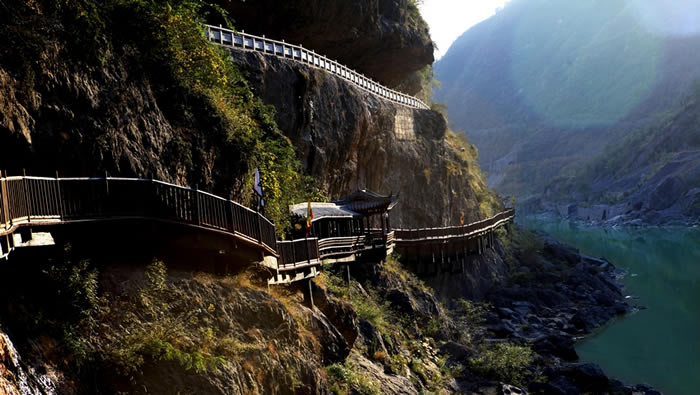Narrow Shu Roads blessed with rich history

The famous Mingyue Gorge Gallery Road is one of the most famous roads to Sichuan. It consists of wooden planks erected on wooden or stone beams and provides a thrilling experience for people to visit.
Li Bai (701-762), a famous poet in the Tang Dynasty (618-907), once said: “Walking on the narrow Shu Roads is more difficult than climbing up to Heaven.” The Shu Roads were a system of mountain roads built in the 4th century BC to join Shaanxi and Sichuan provinces. The Shu Roads get their name from the State of Shu (c. 1045-316 BC), which was in modern-day Sichuan Province.
The Shu Roads generally refer to the ancient transportation system to Sichuan from all directions, but in a narrow sense they are an ancient road system that crosses the Qinling Mountains and Ba Mountain. Since the pre-Qin period, the Shu Roads have been maintained for approximately 3,000 years and the overall length is almost 1,000 kilometers. Today, the Shu Roads are one of the most significant cultural heritage sites.
Like Li Bai, many Chinese poets and writers left rich descriptions of the Shu Roads. This ancient transportation system gives people a magnificent and mysterious impression, mingled with both magic and realistic charm.
The Shu Roads are divided into several ranges, consisting of wooden planks erected on wooden or stone beams. The Jialing River originates from the remote Qinling Mountains, running through Yangpingguan Valley in Shaanxi Province and entering into Mingyue Gorge, 30 kilometers away from the north of Guangyuan City, Sichuan Province. Because Mingyue Gorge is surrounded by mountains, the waterway is long and hard to navigate. The famous Mingyue Gorge Gallery Road, one of the most famous roads to Sichuan, was built to enable passage through the region.
Of all the ruins of the Shu Roads, the section in Guangyuan City of Jinniu Road is among the most well preserved and is considered the most representative. It was the first ruin of the Shu Roads to be listed in the Preparatory Directory for World Cultural Heritage of China.
The experience that people walking the Shu Roads find most thrilling is walking upon the plank roads. These unique plank roads have been preserved to this day and their surrounding ancient stone carvings are an important material carrier of the cultural route of the Shu Roads.
Two thousand years of accumulated history has made the cultural heritage along this route particularly rich. It is a feast for the eyes to walk on the Shu Roads and enjoy its beautiful cultural sites.
For instance, the Thousand Buddha Cliff is one of the most well-known Buddhist stone carvings and is a major national historical and cultural site. Construction on it commenced in the Northern and Southern dynasties (420-589) and continued until the Ming (1368-1644) and Qing (1616-1911) dynasties. In the Sui (581-618) and Tang (618-907) dynasties, the number of Buddha statues built in Thousand Buddha Cliff reached a peak. The total number of statues reached more than 17,000, but now there are only 1,192 cave shrines and approximately 7,000 statues.
In the second half of 2014, Sichuan authorities finished a tentative plan. This means that the application to enter the Shu Roads on the world heritage list has taken the first step.
Zeng Jiang is a reporter at the Chinese Social Sciences Today.
